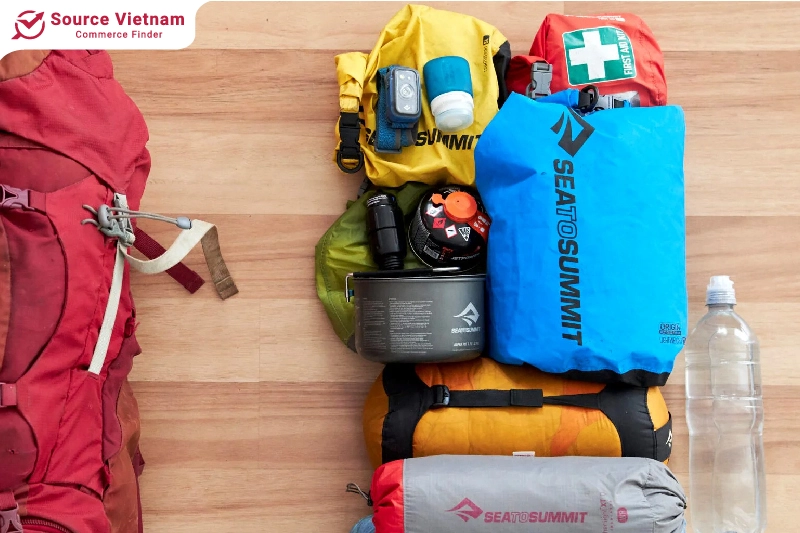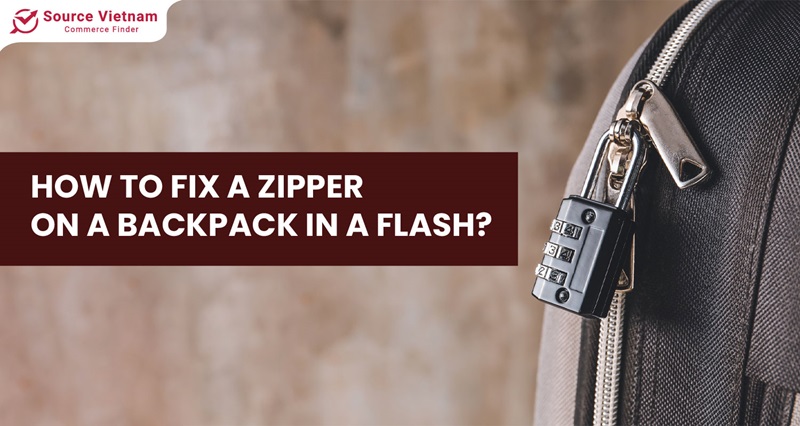Backpacking trips require more thoughtful preparation than regular trips. You need to bring only the essentials and learn proper packing techniques. This article will guide you on how to pack a backpacking bag efficiently, ensuring you bring only the essentials and pack them smartly for a comfortable adventure.
Items list for a backpacking trip
Before we dive into how to pack a backpacking bag, let’s summarize some essential items for your trip. Keep in mind that there’s no one-size-fits-all list, as your choices will depend on your personal habits and preferences. However, this will provide you with a solid foundation of essential items for any backpacking adventure.

Backpacking equipment
A good night’s rest is crucial after a day of exploration on your backpacking trip. That’s why shelter and sleep essentials, like tents, sleeping bags, and sleeping bag liners, are extremely important. For a more effortless packing experience, consider consulting expert tips on how to pack a sleeping bag in a backpack.
You’ll also need other essential gear, such as water purifiers, water bags, and flashlights. Additionally, trekking poles, a daypack, a chair or sit pad, and other comfort items can greatly enhance your experience.
Kitchen gear
While cooking utensils are essential for long backpacking trips, prioritize multi-purpose items that can tackle multiple tasks. Here’s your essential backcountry kitchen checklist: backpacking stove, fuel, dishes, eating utensils, a mug/cup, biodegradable soap, a small quick-dry towel, a food sack, and nylon cord.
Food and water
Pack high-energy foods that are lightweight, easy to store, and have a long shelf life. Ideal options include energy bars, pre-packaged meals with protein, jerky, hard cheeses, and nuts. It is best to bring food that is easy to carry, easy to preserve and has a long shelf life to ensure it lasts throughout the trip.
A small tip that you can research meal plans from experienced backpackers to ensure you bring sufficient calories for your trip duration. In addition to food, you should also plan to bring drinking water, especially if the place where you picnic does not have any clean water source to use. It’s best to refer to formulas to calculate enough water for your trip.
Footwear & clothing
Before packing, check the weather forecast and research your picnic location. This will help you choose the right clothes. Remember, you don’t need to bring identical outfits for every day. If the weather is chilly, pack warm clothes and focus on layering for easy temperature adjustments.

Opt for durable shoes with good traction suitable for various terrains to ensure a comfortable and safe trip. Avoid bringing unsuitable shoes, as this can significantly hinder your enjoyment.
First aid kit
A first-aid kit is an essential item for any picnic. While you don’t need to pack a lot, be sure to include enough bandages, cold medicine, wound disinfectant, insect repellent, and other basic medical supplies.
Don’t forget to pack some personal hygiene items as well, such as hand soap, toilet paper, a toothbrush, menstrual products (if applicable), and prescription glasses (if needed).
Personal items & extras
Don’t forget to pack essential personal items like credit cards, cell phones, permits, and phone chargers. Consider bringing a camera, a daypack for carrying essentials on the go, and two-way radios for communication within your group. A hat is also recommended, depending on the weather conditions.
The parts of a backpack and their features
Bottom-of-pack items
Here are the bulky items you’ll primarily need for evening rest:
- Sleeping bag.
- Sleeping pad.
- Sleepwear (including long underwear, if desired).
- Camp shoes or down booties.
The most important part
Prioritize placing heavy items you won’t need during the move at the bottom of your backpack. This could include your food stash, cook kit, stove, water reservoir (if not using a water bottle or hydration bladder), and bear canister.
Distributing weight evenly and placing heavier items lower in your backpack helps maintain a stable center of gravity. This prevents you from losing balance and makes your trek more comfortable.
Feel free to fill any empty spaces around your bulky items with softer gear like clothes or blankets. This helps prevent them from shifting and keeps your pack organized.
The top part
This section of your backpack should hold bulkier essential items you’ll need throughout your backpacking trip. Include items like insulated and fleece jackets, rain gear, a first-aid kit, and a water filter or purifier. Proper packing techniques for these items are crucial when learning how to pack a bag for backpacking.
Additional pockets included
This backpack goes beyond the main compartment, boasting a variety of additional pockets for easy access to your essentials.
- Front pockets: Conveniently located on the front, these pockets are perfect for frequently used items like maps, compasses, GPS devices, sunglasses, and sunscreen.
- Side pockets: Ideal for storing water bottles and snacks, the side pockets keep these essentials within reach while you’re on the move.
- Waist bags: Offering additional security and organization, the waist bags are perfect for stashing valuables like your phone, wallet, ID, and cash.
Suspension system around the backpack
Our backpacks boast a convenient external attachment system featuring hanging straps. This ingenious system allows you to easily attach essential gear you’ll need throughout your trip, keeping it readily accessible.

Here are some of the items you can secure with these straps: trekking poles, tent poles, large sleeping pad, camp stool or chair (depending on size), ice axe, crampons and climbing rope.
How to arrange a backpack for backpacking
Step 1: Create a packing list and organize your gear
Begin by making a comprehensive list of everything you plan to bring on your trip. Gathering all your items in one place will expedite the packing process and help prevent leaving anything behind. To maintain order within your backpack, categorize your belongings into groups such as shelter/sleeping gear, clothing, food, cooking equipment, and daily essentials.
Visualize the placement of items within your backpack. Heavier items should generally be packed towards the bottom and center for better weight distribution. Lighter items can be placed at the top for easy access. Remember to loosen all backpack straps before packing to simplify the process.
Step 2: Pack the bottom compartment first
Begin by placing bulky items in the bottom compartment. The sleeping pad is typically a foundational piece in your backpack. While some prefer to use waterproof stuff sacks for the sleeping pad, others opt to place it directly at the bottom. The choice depends on the sleeping pad’s size. After securing the sleeping pad, fill the remaining space with camping clothes and pillows.
Step 3: Pack the heaviest item in the middle of the backpack
The middle of your backpack should accommodate the bulk of your heaviest gear, including the tent body, cookware, stove, fuel, and food. To maximize space, utilize any empty spaces within cooking utensils for additional storage. If you’re not using a hydration pack, consider repurposing this area as a water compartment.

Step 4: Pack the top compartment and exterior pockets
Pack the remaining lighter items in the top compartment according to your preference. Prioritize essential items for easy access. Utilize hip pockets, smaller exterior pockets, and any hanging attachment points for additional storage.
Step 5: Conduct a final check
Before setting off, thoroughly review your packing list to ensure that no essential items have been forgotten. Overlooking important items can significantly impact your trip, so a final inspection is crucial.
Choose the right gear for your trip
Resist the urge to grab a backpack in bulk before your trip, the season and destination of your backpacking adventure significantly influence your packing list, including the size and features of your backpack.
- Summer trips (or warm climates) generally require lighter sleeping bags and fewer warm clothing items. Conversely, cold-weather destinations demand adequate gear to stay warm.
- The duration of your trip determines your food supply. Outdoor equipment tends to remain consistent across trips, allowing you to reuse items. A common guideline suggests carrying 2-2.5 pounds of food per person per day, which can serve as a starting point for your calculations.
Tips for organizing your backpacking backpack
- It’s challenging to insert a full water bag into a backpack after packing other items. Therefore, prioritize placing your water bag inside first, followed by the rest of your gear.
- Carefully consider essential items and create a packing list to avoid unnecessary weight and bulk.
- Overloading your backpack can be uncomfortable and physically demanding. Ideally, your backpack should weigh approximately one-third of your body weight. For women, a quarter of body weight is generally recommended, with a maximum of 12 kilograms.
- Utilize a sturdy, waterproof liner within your backpack. A bright orange liner can serve as a visible emergency signal.
- Pack bulky items, tents, and sleeping gear first, followed by outer compartments. Avoid placing sharp metal objects against your back to prevent discomfort and potential injury.

- Keep protective items such as raincoats and backpacks in easy-to-reach places to ensure you can get them as quickly as possible when it rains.
- Your backpack will be worn throughout the trip, so make sure it is balanced. If you do not fill the backpack with items, use the straps to tighten the empty areas, ensuring the objects inside are stable and do not swing during movement.
- No matter what you bring on your trip, always make sure you have the necessary items such as: whistle, first aid kit, survival bag, waterproof poncho or jacket, torch, compass, GPS or map, water bottle, cell phone.
- When traveling with children, consider additional strategies for efficient packing, including mastering the art of how to pack a diaper bag backpack and more items for your kid.
A wide range of wholesale gear is available on Sourcevietnam.com
Supercharge your backpack business with Sourcevietnam, your trusted partner for backpack wholesale. Our extensive marketplace connects you directly with a network of established Vietnamese suppliers, offering a diverse selection of high-quality bulk backpacks at unbeatable wholesale prices
- Easy payment process, international payment support.
- No need to worry about shipping large quantities, Sourcevietnam will support you throughout the shipping process.
- Source directly from reputable factories/suppliers with clear information.
- Import goods at the best wholesale prices.
Choose Sourcevietnam to start your import journey and business today!
Above is a detailed guide on how to pack a backpacking bag for your trip. In addition, you can also visit Sourcevietnam.com to find products for your backpacking trip at the best wholesale prices. Sourcevietnam.com – a B2B e-commerce platform providing quality products at good prices!













